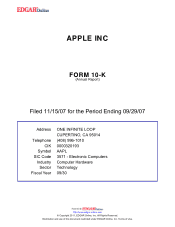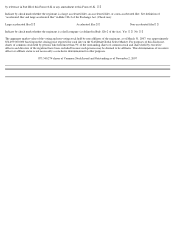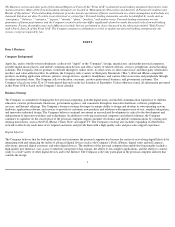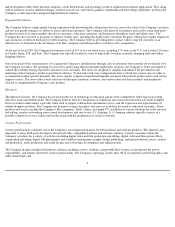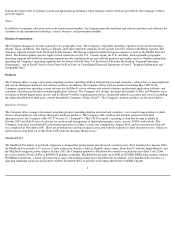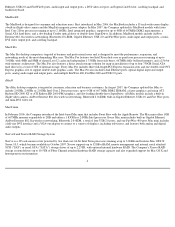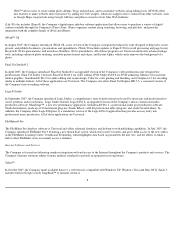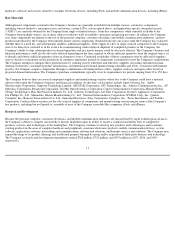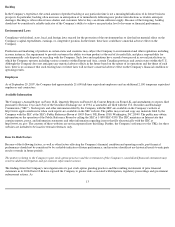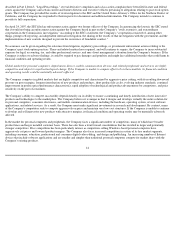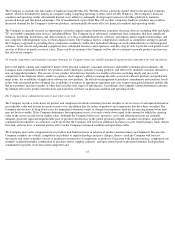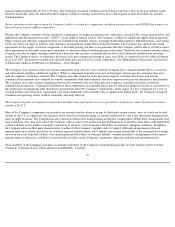Apple 2007 Annual Report Download - page 9
Download and view the complete annual report
Please find page 9 of the 2007 Apple annual report below. You can navigate through the pages in the report by either clicking on the pages listed below, or by using the keyword search tool below to find specific information within the annual report.
September 2007, the Company introduced the iTunes Wi-Fi Music Store offering users the ability to browse, search, preview, purchase, and
download songs and albums from their iPod touch or iPhone over a Wi-Fi network. Customers can search the contents of the store catalog to
locate works by title, artist, or album, or browse the entire contents of the store by genre. Originally introduced in the U.S. in April 2003, the
iTunes Store now serves customers in 22 countries.
iPhone™
In January 2007, the Company announced iPhone ™ , a handheld device that combines in a single product a mobile phone, a widescreen iPod
with touch controls, and an Internet communications device. iPhone's user interface is based on the Multi-Touch™ display allowing users to
control the device with a touchscreen. iPhone lets users make calls by tapping on a name or number in their address book, a favorites list, or a
call log as well as select and listen to voicemail messages in any order. iPhone also allows users to purchase and download songs and albums
from the iTunes Wi-Fi Music Store directly onto their iPhone and play their iTunes® content, including movies, television shows, music, photos
and podcasts, with the touch of a finger. iPhone features desktop-class email, web browsing, searching, and maps. iPhone is compatible with a
Mac or PC and automatically syncs content from a user's iTunes library, as well as contacts, bookmarks, and email accounts. iPhone is a quad-
band GSM phone featuring EDGE and Wi-Fi wireless technologies for data networking, Bluetooth 2.0, a built-in 2 megapixel camera, a 3.5-
inch
touch screen with 480-by-
320 resolution at 160 pixels per inch, and providing up to 8 hours of talk time, 6 hours of Internet use, 7 hours of video
playback or 24 hours of audio playback. AT&T Mobility LLC ("AT&T") is the exclusive U.S. cellular network carrier for iPhone. The Company
began shipping iPhone in the U.S. on June 29, 2007. On November 9, 2007, the Company began shipping iPhone in the U.K. and Germany, and
expects to ship the iPhone in France on November 29, 2007. O2 Limited ("O2"), T-Mobile International AG & Co. KG ("T-Mobile"), and
France Telecom ("Orange") are the exclusive cellular network carriers for iPhone in the U.K., Germany, and France, respectively. The Company
has entered into agreements with each exclusive cellular network carrier related to cellular network services and the purchase and sale of iPhone
and iPhone related products. These agreements entitle the Company to receive certain payments from these carriers.
In addition to the Company's own iPhone accessories, third-party iPhone compatible products are available, either through the Company's online
and retail stores or from third parties, including headsets, cables and docks, power supplies, and carrying cases.
Peripheral Products
The Company sells a variety of Apple-branded and third-party Mac-compatible peripheral products directly to end-users through its retail and
online stores, including printers, storage devices, computer memory, digital video and still cameras, and various other computing products and
supplies.
Displays
The Company manufactures a family of widescreen flat panel displays including the 30-inch Apple Cinema HD Display™, a widescreen active-
matrix LCD with 2560-by-1600 pixel resolution, the 23-inch Apple Cinema HD Display with 1920-by-1200 pixel resolution and the 20-inch
Apple Cinema Display® with 1680-by-1050 pixel resolution. These displays feature built-in dual FireWire and dual USB 2.0 ports and use the
industry standard DVI interface for a pure digital connection with the Company's latest Mac Pro, MacBook Pro, Mac mini and MacBook
systems. The Cinema Displays feature an aluminum design with a thin bezel, suspended by an aluminum stand that allows viewing angle
adjustment.
Apple TV™
In January 2007, the Company announced Apple TV, a device that permits users to wirelessly play iTunes content on a widescreen television.
Compatible with a Mac or Windows-based computer, Apple TV includes either a 40GB or 160GB hard drive capable of storing up to 200 hours
of video, 36,000 songs,
6

